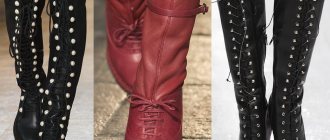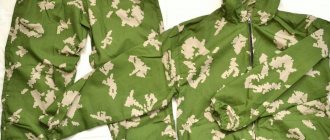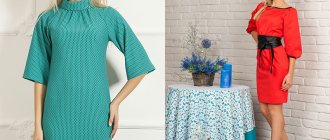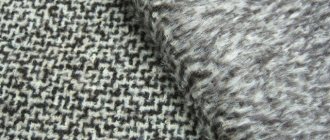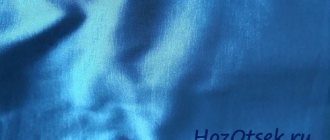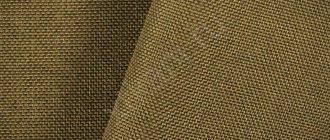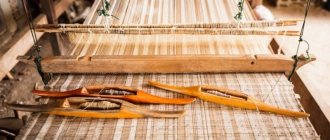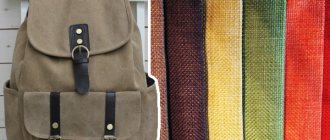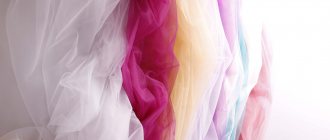The purpose of camouflage clothing is to make a person invisible against the background of the environment. Initially, it was a uniform for the military, hunters and fishermen. Today, camouflage fabric is used to sew jackets, vests, trousers, and hats for everyday wear. Such clothes are more suitable for men, but among the fair sex there are lovers of such outfits. This article will discuss the types of camouflage fabric, its properties, and conditions for caring for things made from it.
Variety of fabrics for the production of summer camouflage suits
The following types of fabric are often used for summer camouflage clothing:
Oxford
Classic synthetic fabric, which consists of nylon and polyester. It has a square weave when the threads are woven together in the shape of squares. The main advantages of the fabric are durability, strength and water resistance, as well as resistance to chemical compounds. The material retains heat well and does not allow cold air to pass through.
Protective fabric
For your information! The fabric depends on the thickness of the threads and is divided into types from 210D to 600D. It is used to make clothes, shoes and military backpacks.
When washing, it is advisable to monitor the water, the temperature of which should not be higher than 50°C. It is better to choose cleaning products special for synthetic fabrics. When washing in a machine, you should set it to delicate; it is better to avoid spinning. You can dry things by hanging them on hangers. Then they don't need ironing.
Oxford material
Rip stop
The fabric contains polyester reinforced thread and cotton particles. Lattice-type weaving makes the fabric resistant to mechanical defects, that is, it will not unravel at the edges. This fabric hardly wrinkles, and also does not shrink with each wash. Wear-resistant and durable. It is advisable to wash at a temperature of about 40°C in hand wash mode. Can also be dried on hangers, no ironing required.
Greta fabric
The composition includes polyester and cotton. Due to the special type of weaving, the cotton thread is located on the inside of the material, and the synthetic thread is located on the outside. Greta has high wear resistance, retains heat well, and absorbs moisture well. It is advisable to wash at a temperature not exceeding 60°C. If this number is higher, the item will instantly lose its properties. The ideal mode is hand washing. Spin should not be higher than 600 rpm. Drying should be in a vertical position, and ironed only from the inside out.
Greta fabric
Fleece
To create this camouflage fabric, polar fleece fiber is used, which is 100% polyester. The fabric is created in such a way that there are air chambers in its structure. This fabric is hypoallergenic, lasts a long time, is pleasant to the touch, and does not shrink when washed. Wash only in synthetic mode, spin up to 600 rpm. Dry vertically. The material does not wrinkle, so there is no need to iron it.
You might be interested in Features of silk-screen printing on T-shirts and other fabrics
Shirt fabric
This is a mixed type of fabric made from polyester and viscose. It washes well, is soft to the touch and does not cause skin allergies. Caps and bandanas are also made from this fabric. Can be washed in warm water no higher than 70°C. Preferably in synthetic or cotton mode. When spinning, set it to no more than 1000 rpm. Ironing must be done in the same modes as washing.
Mixed material
Membrane
Membrane fabric does not hinder movement and protects well from rain, drafts and frost. Moisture from the body will escape, making the first layer of fabric dry. Wash carefully at a temperature not exceeding 40°C. It is better to rinse two or three times and avoid spinning. You need to dry it in a horizontal position, away from heating appliances.
Tarpaulin
A fairly dense and coarse material, which is created from thick yarn. The composition includes threads made of jute and cotton. The main characteristics of this fabric are strength and resistance to mechanical damage (cuts and tears). The fabric is wear-resistant and does not allow moisture to pass through. It is quite difficult to wash it, since water makes the material heavy and rough, which can also disrupt its impregnation.
Note! It is better to wash by hand using soap and a brush, and dry in a horizontal position.
Fabric tarpaulin
Avizent
Also called aircraft tarpaulin. This is a heavy material that is used for the production of awnings and high-strength equipment. It is highly resistant to mechanical damage and tearing. Caring for the fabric is exactly the same as for tarpaulin.
Types of camouflage materials by application areas
There are many varieties of jacket fabric for sewing camouflage suits; they are divided into groups according to areas of application: army camouflage, hunting, for fishermen and clothing for active recreation..
Army camouflage is a textile for making uniforms for the army, law enforcement agencies, police, and security agencies. For this type of uniform, cotton and impregnated mixed materials are used, the most popular of which are: Oxford, raincoat, fleece.
Depending on the season and terrain, hunting camouflage can be summer or winter. Lightweight textiles are made from cotton, wool or chemical fibers. For the cold season, camouflage fabric is produced with an additional warm layer. To prevent clothes of this type from getting wet, the fabric is treated with impregnation. In demand in the production of hunting suits are raincoat fabric, Oxford, fleece, and Rib-stop.
Based on colors, outdoor fabrics for sewing hunter uniforms are divided into the following types: Dark Forest, Flora, Autumn Forest, Snowy Forest, etc. The composition of jacket fabric for sewing fishermen's uniforms is the same as in hunting suits, only here the impregnation is made in a thicker layer to increase the water-repellent properties of the material. Oxford, raincoat, Rib-Stop, Greta are the street fabrics that are used in the production of suits of this type. Textile colors of suits for fishermen – Storm, Reed.
Camouflage for outdoor activities includes both light clothing (T-shirts, T-shirts, Panama hats) and warm clothing (jackets, vests, raincoats, overalls, pants). Based on the composition of the fibers for the production of this type of clothing, more natural cotton or wool are used. Fleece and shirt material are those types of textiles from which camouflage for active recreation is pleasant to the body, soft and warm. Often such clothing is equipped with reflective elements.
Basics of Camouflage Pattern Construction
Camouflage color is used to make the object on which it is applied invisible. To achieve this goal, coloring has two purposes:
- deforming - violation of the integrity of the perception of the visible;
- imitation - ensures the inseparability of the object from the general background.
The deforming purpose is carried out in modern costumes mainly by fragmenting the object’s figure into several contrasting colored parts. And the imitation is realized through the use of a color scheme similar to that characteristic of the place where the costume will be used, through the simulation of natural objects (trees, bushes, water, mountains, etc.).
Russian camouflage
Camouflage in Russia and the Soviet Union
The digital camouflage of the Russian army is today called “digital flora”. Abroad, this suit is known as Russian Pattern, and in the Russian army it is referred to as “Pixel”. This suit was created in 2007, and was supplied to the military only a year after the decision was made to replace Flora.
You might be interested in this Description of the melange color of fabric in clothing
Color “Birch”
Over the many years since the times of the USSR, the following types of camouflage have been created:
- "Amoeba". Created in 1935. Produced in three types;
- "Deciduous Forest" was created in 1942;
- "Palm". The camouflage pattern was created in 1944. Each season had its own suit;
- “Silver Leaf” was created in 1957. The army suit was also called “Beryozka”, or KGB camouflage. May be white or yellow;
- "Butane" or "Oak". Was created in 1984;
- Russian camouflage pattern released in 1993;
- "Undergrowth" camouflage is the first dual-frequency suit. Has good camouflage, but is very easily damaged;
- Digital Russian camouflage, which is worn in the army now;
- yellow camouflage "Flora" is mainly used by the troops of the North Caucasian Federal District in the summer, when the grass is faded.
Note! Many of these types of camouflage are optional. They have also found private use in security agencies.
Special Russian organizations also produce camouflage equipment that was developed in the West. In addition, Russia is constantly improving the functions of the suits that are currently available, and also creating new types of camouflage equipped with even better characteristics.
Forest suit
Types of camouflage colors
Several camouflage color options are used in the design of military and civilian clothing. The most popular color, usually used when sewing a soldier's uniform, is khaki (a dusty earthy shade). Much more interesting is spotted camouflage. In the design of camouflage clothing, patterns in the form of spots resembling leaves, vegetation, amoeba, and pixel configuration are allowed.
Main types of camouflage:
summer (green-brown tones);
- winter (white and gray colors);
- demi-season (gray-green-brown colors).
Camouflage color options:
- plain - khaki, olive, dark green, brown;
- “forest” - greenish-brown spots reminiscent of a geographical map;
- “desert” - spotted beige-brown pattern;
- “jungle” - green-brown spots and black strokes;
- “winter” - a spotted grayish pattern on a white background;
- “bush” - images of animals or parts of the world on a green background;
- “silver leaf” - pixel pattern on an olive background;
- “vertical” - green-brown merging spots;
- “flora” - watermelon pattern;
- “oak” (“butane”) - pastel green spotted color;
- “tiger” (“reed”) - khaki background and chaotic stripes;
- “digital flora” - a spotted greenish pattern with dots;
- “digital” - in the form of green-brown pixels;
- 3D drawing - a blurry gray-brown image using optical illusion.
Camouflage options used when sewing fashionable clothes:
- “pixel” - a spotted pixel pattern of white-gray or green-brown color;
- “amoeba” - green and brown spots on a pastel background;
- "urban" - white and black dots or strokes on a grayish background;
- “geometry” - green-brown or gray-brown triangles or geometric shapes of irregular shape.
Modern camouflage of Eastern Europe
Modern camouflage is divided into five categories:
- forest (used in Russia, Europe, northern part of the USA);
- sand camouflage (used in northern Africa, part of Asia, the Middle East, in sandy areas where desert wind prevails);
- for the jungle (southern USA, southern Asia, and Syrian terrain);
- winter (mainly used where the climate is arctic);
- "Bush" (designed with characteristics for southern Africa, this category includes several types of suits).
Simply put, any camouflage texture that is currently available belongs to one of five groups.
Important! There are also additional categories "City" and "Miscellaneous". City - intended for use in an urban environment, and the second to describe suits that work on a different principle than traditional camouflage colors.
Woodland
Military camouflage of other countries
A well-known type of forest camouflage is the Woodland pattern. He is the most popular and famous. This costume began to be made in the 70s. Its purpose is for camouflage in forests. The Woodland camouflage color is a classic among other suits.
You might be interested in what is the best material to make underwear from: choice of fabric
The German Flecktarn camouflage deserves special attention. Basically, he is the leader among foreign costumes in Russia. This type was adopted by the German army in the mid-90s. Since then it has proven itself well and still has an excellent reputation.
Mountain suit
There is also a mountain type of suit with large spots. It camouflages well in Central European areas. The main colors are dark and brown, but there is also a gray khaki camouflage. This suit is still in service with the German military forces and there are no plans to change it yet.
The English costume is also quite well known in the Russian Federation, although in terms of camouflage it is inferior to the German ones. Its advantage is its low price, since the British Armed Forces adopted a different camouflage pattern.
For your information! In Russia, English camouflage, due to its quality and price, is used mainly for fishing or hunting.
Austria is one of several countries that changed from multi-colored camouflage to solid color, rather than the other way around.
Alpenflage
Due to the fact that at long distances almost every outfit looks the same color, Austrian scientists decided to opt for olive-colored suits (later it was swamp color). This color copes well with the task of camouflage. At the same time, camouflage can be worn in the city and not stand out among civilians.
Alpenflage is an unusual red camouflage that symbolizes the red flowers of spring. For use exclusively in Switzerland.
Navy Blue is a British blue navy camouflage created in 1974. Many countries have chosen the same design, only the blue has been replaced with light blue.
Camouflage fabrics wholesale from the company "MARA"
A wide variety of technologies and combinations of fibers are used by the textile industry to create a product that has unique, inherent abilities that meet consumer requirements. Practical and attractive fabrics receive most preferences. This is considered the name “Greta”, which is the result of many years of improvement of the technological process at the MARA enterprise.
Brief characteristics of the material
It is a mixed material ideal for creating products in many types of textile industries. This is due to the fact that the fabric is dense, resistant to abrasion, wear, lightweight, easy to care for, and does not cause discomfort during use. It consists of 51% cotton fibers, 49% polyester, has a material density of 210 g per 1 square meter, a width of 150 m. You can learn more about the offers and buy camouflage fabric by visiting the official website of the company.
Thanks to almost the same proportion of the constituent components, durability, lightness, a plain or printed matte-silky surface are achieved.
The technological process uses a twill type of weaving, which makes the fabric double-sided with a diagonal rib (increases water-repellent properties), polyester faces outward (makes it easy to care for), and cotton faces inward (makes the fabric hygienic, hypoallergenic, pleasant to the body). The material is impregnated with agents and coatings to impart versatility and acquire new properties:
- water-repellent;
- oil-repellent;
- oil-repellent;
- dirt-repellent;
- windproof.
The finished product does not wrinkle, does not fade under the influence of UV radiation, after repeated washings, it is practical to use, and various types of dirt are easily cleaned without the use of cleaning agents. Dust particles will not penetrate into the fabric due to the increased density.
They sew from it:
- workwear;
- uniforms for various industries;
- products for oil and gas, energy enterprises, utilities, builders, road workers;
- protective vests;
- equipment, suits for athletes and tourists.
It is allowed to wash cloth with water heating below the upper limit of 60℃ without using chlorine-containing bleaches, ironing at medium heat.
Customers who have purchased MARA brand canvases note high consumer qualities, water-repellent properties, durability, and a variety of shades.
Interested in fabrics?
You can find out more about the purchase, assortment, consult regarding the selection and ordering procedure, delivery method by calling or using the “call back” function. Also contact the main office at the address 109145, Moscow, Privolnaya street, possession 12. Check office hours at the above numbers, or ask questions by email This email address is being protected from spambots. You must have JavaScript enabled to view, contact us via Skype, WhatApp, Viber, social network VK.
Our advantages over competitors
“MARA” has been working on the production of various types of textiles for workwear for more than twenty-five years, giving it new and practical properties, thanks to which it has taken a leading position in the domestic market. Main advantages of the brand:
- Loyal prices. We regularly provide discounts, depending not only on volume, but also on the regularity of purchases, and also place promotional offers.
- Rich assortment. The buyer can always choose the right material without wasting time waiting, since we guarantee their constant availability in warehouses.
- Individual approach, 100% fulfillment of exclusive orders. Qualified personnel. Excellent reputation and positive feedback from many clients.
Order camouflage fabric wholesale from and receive a high-quality certified product, the price of which will not cause discomfort.
Modern pixel camouflage
In mid-1984, the Russian Federation began to use camouflage called pixel camouflage. These colors are very similar to the pixels of monitor screens. They make it difficult to focus on objects, forcing you to perceive them as noise in front of your eyes. Pixels also make it difficult to determine the speed of an object's movement.
Pixel cloth
Important! Previously, countries had different approaches to military uniforms, but now everyone has a tendency to have universal colors. It is modified only depending on the type of terrain where it will be used.
Thus, the camouflage uniform changes quite often. The armed forces keep up with the times and always improve existing models. Also, in addition to employees, camouflage can be used by fishermen or hunters. There are special children's costumes for the child to wear outdoors or during active recreation. They can be easily ordered in the online store. Which color to choose is described above.
The history of camouflage fabric
Translation from French of the word “camouflage” means “camouflage”. For the first time, camouflage fabric was made for the British - soldiers of the Anglo-Boer War (1899). For the soldiers, they sewed uniforms in a marsh color, which they called “khaki.” During World War II, there were already up to 30 varieties of colors and shades of camouflage fabric; they were widely used by German soldiers. The Soviet Army also quickly adopted camouflage fabric. One of the most popular and relevant to this day is the “birch” uniform in black and white. During the Cold War, camouflage suits made from camouflage fabric were divided into several types, depending on the pattern on the canvas: “Forest”; "Jungle"; "Desert"; "Bush"; "Winter".
